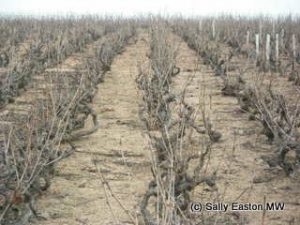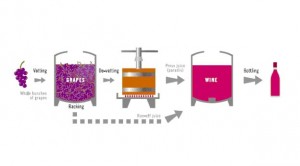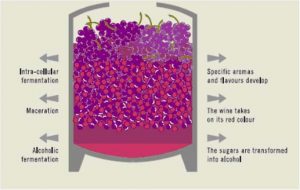Semi-carbonic maceration

Beaujolais
Carbonic maceration and semi-carbonic maceration are not quite the preserve of Beaujolais and the gamay grape, but this is the region where the techniques reach complex and varied permutations. Having recently visited, I’ve become fascinated by the process which can produce such vibrant, lively, fresh, and sometimes also very serious, wines. I’m also intrigued that other places are experimenting with proportions of ‘whole bunch fermentation’ (more of which later). So, mostly in preparation for a tasting seminar I delivered in May (posted here), I put together the following book research of the basics.
Carbonic maceration uses whole bunches only, and requires a vessel that can be filled with carbon dioxide and closed to prevent the ingress of air (Bird, 2010: 98). The first stage is an intra-cellular, anaerobic, enzymatic metabolism inside each berry, without the interaction of yeast. (Bird 2010: 99, OCW 2006: 138, Iland, Gago, Caillard, Dry 2009: 161, Rankine 2004: 100).
The absence of oxygen causes a shift from respiratory to fermentative metabolism (Jackson 1994: 350), and this shift is more rapid when carbon dioxide has been used to flush the vessel. Rankine (op. cit.) adds there must be enough carbon dioxide to prevent spoilage micro-organisms including acetobacter from growing.
True carbonic maceration appears to be quite rare, rather technical, and quite difficult because the weight of bunches inevitably crushes fruit at the bottom releasing some juice, but if the vessel is fully flushed with carbon dioxide then there is no oxygen to stimulate an alcoholic fermentation (OCW op. cit).

Semi-carbonic maceration
Inside the berry, enzymes convert the grape sugars to alcohol (Bird, op. cit: 99). These reactions cause the temperature to rise to between 30 and 35°C (Bird, ibid). A temperature of 35°C will kill the berry after about eight days and this stretches to about two weeks at 15°C. (Rankine, op cit.).
The Oxford Companion to Wine (2006: 138) states studies show that whole, intact grapes under carbon dioxide:
- lose 20% of their sugar
- gain 2% in alcoholic strength
- gain 10 times the amount of glycerol
- lose 50% of malic acid
- increase pH by 0.25 units
Along with these changes, flavourful and aromatic compounds are also produced. The loss of malic acid inside the berry is not due to malolactic fermentation – Jackson; Rankine (op cit) state the malic acid is metabolised to other acids including oxaloacetic, pyruvic and succinic acids, as well as to alcohol.
Rankine (op. cit: 101) adds 30-35°C is optimal as changes in the above take place more rapidly at the warmer temperature.
As the carbonic maceration process goes on, phenolic compounds are extracted within the berry, with anthocyanins being more readily dissolved than tannins (Jackon, op. cit).

Semi-carbonic maceration
The vats where semi-carbonic maceration is to be done may or may not be flushed with carbon dioxide. Full vats might be topped with carbon dioxide, or not. The intracellular bit remains the same, plus there is an accompanying proportion of alcoholic fermentation at the bottom of the vat. Carbon dioxide released from this portion keeps the intact berries above in an anaerobic environment (Bird, op. cit: 100; Iland et al. op. cit: 161).
True carbonic maceration extracts less colour than semi-carbonic maceration (Bird: op. cit: 100) , which has more macerating must/fruit at the bottom of the vat. Here, the higher alcohol in must at the bottom of the vat extracts a greater amount of colour and tannin from the fruit (Jackson: op. cit: 351).
Phase one, the intracellular phase, finishes when alcohol reaches about 2%, causing the death of the berry, or when grapes burst, usually by weight from above (Rankine, op. cit: 100).
Once this intracellular process is complete, grapes are pressed. Free run wine, produced by alcohol fermentation due to the weight of fruit above may be run off to a separate vat.
In contrast to a de-stemmed fermentation, the press wine is the best quality (Bird; Rankine, op.cit.). Claude-Vincent Geoffray, the owner of Château Thivin in Beaujolais said the press juice “is very coloured, very perfumed, very fruity with lots of sugar and some alcohol. It is called ‘paradis’”.
This first stage maceration (whether from full or semi-carbonic maceration) can last from a few days to a few weeks. As with destemmed-fruit fermentation, time and temperature are important factors. Classically, and simplistically, Beaujolais Nouveau has a 4-day maceration, Beaujolais and Beaujolais Villages a 6-day maceration, and Beaujolais crus a 10-day maceration. (InterBeaujolais: undated)
The second stage, the alcoholic fermentation and malolactic fermentation then take place (Jackson op. cit: 347). Bird (op. cit) suggests a modest temperature of 20°C to preserve the fragrance of the carbonic maceration phase.
It is the fragrance of the carbonic and semi-carbonic maceration flavours that mark out this vinification technique. Jackson (op. cit: 349) cites Flanzy’s descriptors including hyacinth, vanilla, cherry, banana, and raspberry. Rankine (op. cit: 101) adds cherry flavours, with a fresh, aromatic nose. Kirsch is added by OCW (op. cit: 620), plus confectionary, bubblegum and cinnamon by Iland et. al (op. cit).
And from Ducruet (1984), Jackson (op. cit: 350) cites “higher concentrations of ethyl decanoate [fruity], eugenol [clove], methyl and ethyl vanillates [vanilla], ethyl and vinyl guaiacols [smoke], and ethyl and vinyl phenols [spice] develop during carbonic maceration than in traditional vinfication.” Does this suggest wines made by semi-carbonic maceration may be uniquely identifiable in the glass?
In addition to this spectrum of bright aroma and flavour characters, semi-carbonic maceration wines generally have less colour and tannin than wines made using destemmed fruit with punchdown, pumpover, rack and return. (Rankine, op. cit: 101). Anecdotally, alcohol is often not too high, which is a bonus given current trends.
This is the basic model of semi-carbonic maceration. Brightness and perfume of fruit are hallmarks of these wines, as are a modesty of colour and moderation of tannin. Onto this template can be superimposed plenty of technique-tweaking, for example a longer maceration for more colour.
Alternatively, on his Côte de Brouilly, Geoffray “adds up to 20% of de-stemmed grapes, so it is not too estery”, while Julien Sunier, for whom the colour is largely unimportant, does “pretty much full carbonic, covering with gas after every load, but with a two to three week maceration.”
Bibliography
- Bird, David, (2010), Understanding Wine Technology (3rd edition), DBQA Publishing
- Iland, Patrick; Gago, Peter; Caillard, Andrew; Dry, Peter (2009) A Taste of the World of Wine, Patrick Iland Wine Promotions.
- InterBeaujolais, (undated) The land and the vines in the Beaujolais region
- Jackson, Ron, 1994, Wine Science, principles and applications, Academic Press
- Rankine, Bryce (2004), Making Good Wine, Macmillan
- Robinson, Jancis (ed), (2006), Oxford Companion to Wine (3rd edition), OUP
Comments
6 Responses to “Semi-carbonic maceration”




July 15, 2012 at 12:09 pm
Thank you for an informative article, Sally. Do you have any figures for how prevalent “true” carbonic maceration is? I thought that was quite commonly used for large scale production of plain (not villgages or cru) Beaujolais, so was not rare. I could be wrong but I think I got that impression from Bird’s book.
July 15, 2012 at 4:23 pm
Hi Steve, sorry, no I have no idea about the prevalence of full carbonic maceration in Beaujolais. Anyone else?
October 28, 2012 at 3:59 pm
That is a very helpful summary, Sally, thank you. It begins to answer my question as to why wine made with CM or semi-CM is deeply coloured. This is counterintuitive given that the colour is in the skins which have not been broken. The hint here is: phenolic compounds are extracted within the berry, with anthocyanins being more readily dissolved than tannins (Jackson). Is there any more that can be said about this?
October 30, 2012 at 9:53 am
Hi David,
I’m not sure about carb mac wines being deeply coloured. Jackson just says colour is more readily dissolved than tannin. And there’s not usually too much tannin in carb mac wines. I guess it partially depends on how long is the maceration – that can vary from a few days to a few weeks, so more colour the longer maceration.
Came across this today, if it helps: http://www.newworldwinemaker.com/articles/view?id=393
December 13, 2017 at 4:35 pm
I have to explain to one of my japanese client what is carbonic maceration and I would like to find your picture of semi-carbonic maceration but with a finer resolution so we can read the text.
Best regards
Daniel Dutronc
December 13, 2017 at 4:44 pm
If you hold your cursor over the images, you can see the source of the image – it is from the Beaujolais interprofession. Please correspond with them directly for higher resolution images.